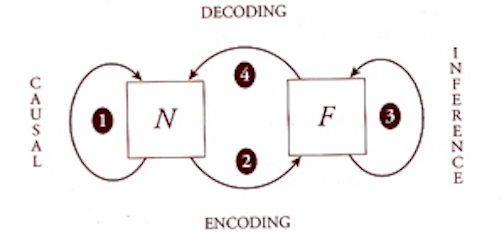The following was a post I put up on Facebook that David Ing suggested belonged here, as well:
In Return of the Jedi, Emperor Palpatine constantly speaks of having “foreseen” what’s going on. But he is ultimately completely wrong in how things end up. So, it’s not prophecy, it’s prediction that he’s using.
And prediction requires models. Accurate predictions require well-encoded models that are being appropriately applied. There’s a lot of room for trouble, there! Especially because time means change, so even what was once an accurate model will phase out of accuracy. And it doesn’t tell you when it does so. That’s one of the ways that error creeps in.
I’ve pointed out that the error signal is proof that there are models at work in a given causal process in biological systems, such as a prediction that proves to be incorrect. This is part of Anticipatory Systems Theory as developed by Robert Rosen. The existence of the capacity for error is inescapable in any activity that involves models and since all life (and mind) uses model-based guidance, that potential for error is exploited all the time by the evolution of species.
What is camouflage? What is a hunting lure? What is mimicry? These behaviors are all around us in the natural world. They are all about causing an error in some other species’ guidance model’s predictions. Garbling another species interpretation of information-- the prediction of what something means, for either protective purposes or for predatory purposes… of maybe for reproductive purposes.
I’m always on the lookout for ways to make these concepts more understandable because I think science and humanity generally needs to understand this stuff. My father’s scientific work isn’t just for people at, or approaching, his level of technical and mathematical prowess! These concepts are universally applicable if you are alive and intelligent, and living in an ecosystem on Earth (or trying to design ecosystems for anywhere else)… Here’s a prediction for you: No matter what you plan to do, you’re going to be using models to do it. It is unavoidable, both somatically and mentally. So, it behooves us to understand fully what that means. I think I’m kind of uniquely place to be able to help with that. But I need to hone my own communication skills to be able to do it well.

Robert Rosen’s diagram of The Modeling Relation. N stands for “Natural System” and F stands for “Formal System” (the model). Arrow #1 represents the entailment by which the Natural System is doing what it is doing; the Causal Entailment. Arrow #3 represents the encoded version of that entailment into a model; the Inferential Entailment. There’s a lot of information packed into this nifty little diagram he created. For one thing, it shows how it is that there is nothing about the Natural System that tells us how to go about building a good model of it. The encoding and decoding arrows represent, among other things, the work of Science or of the human mind (from which Science springs) trying to figure something out. It’s up to us how to model anything-- and how/when to apply the model once we build it. It is our responsibility to keep decoding-- keep checking the predictions against the actual system to make sure it is still accurate and we are still applying it appropriately.
 (first …fix the grammar in the sentence that has the words "uniquely place’)…Second …a few questions. Why should we expect the Natural Realm and the Formal Realm to require (or have the capacity ‘to be’) connected and relevant? What benefit(s) is/are in that association? What are the mechanisms of energy and information “redistribution” involved? What mechanisms of coding (aka relevance interpretation) did Robert cite or specify? If he -didn’t- … how would -you- fill in those answers? What do those answers inform you about the qualities of systems a) behaviors, b) capacities for performance and data/information transforming (processing;using usefully)?
(first …fix the grammar in the sentence that has the words "uniquely place’)…Second …a few questions. Why should we expect the Natural Realm and the Formal Realm to require (or have the capacity ‘to be’) connected and relevant? What benefit(s) is/are in that association? What are the mechanisms of energy and information “redistribution” involved? What mechanisms of coding (aka relevance interpretation) did Robert cite or specify? If he -didn’t- … how would -you- fill in those answers? What do those answers inform you about the qualities of systems a) behaviors, b) capacities for performance and data/information transforming (processing;using usefully)?